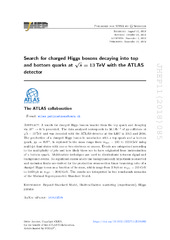Search for charged Higgs bosons decaying into top and bottom quarks at √s=13 TeV with the ATLAS detector
Aaboud, Morad; Aad, Georges; Abbott, Brad; Abdinov, Ovsat Bahram oglu; Abeloos, Baptiste; Abhayasinghe, Deshan Kavishka; Abidi, Syed Haider; AbouZeid, Hass; Abraham, Nadine L.; Abramowicz, Halina; Buanes, Trygve; Eigen, Gerald; Fomin, Nikolai; Lipniacka, Anna; Martin dit Latour, Bertrand; Mæland, Steffen; Stugu, Bjarne; Yang, Zongchang; Zalieckas, Justas; Bugge, Magnar Kopangen; Cameron, David Gordon; Catmore, James Richard; Feigl, Simon; Franconi, Laura; Garonne, Vincent; Gramstad, Eirik; Hellesund, Simen; Morisbak, Vanja; Oppen, Henrik; Ould-Saada, Farid; Pedersen, Maiken; Read, Alexander Lincoln; Røhne, Ole Myren; Sandaker, Heidi; Serfon, Cédric; Stapnes, Steinar; Vadla, Knut Oddvar Høie; Abreu, Henso; Abulaiti, Yiming; Acharya, Bobby S.; Adachi, Shunsuke; Adamczyk, Leszek; Adelman, Jareed; Adersberger, Michael; Adigüzel, Aytül; Adye, Tim; Affolder, Anthony Allen; Afik, Yoav; Agheorghiesei, Catalin; Aguilar Saavedra, Juan Antonio; ATLAS, Collaboration
Peer reviewed, Journal article
Published version

Åpne
Permanent lenke
https://hdl.handle.net/1956/20596Utgivelsesdato
2018-11Metadata
Vis full innførselSamlinger
Originalversjon
https://doi.org/10.1007/jhep11(2018)085Sammendrag
A search for charged Higgs bosons heavier than the top quark and decaying via H± → tb is presented. The data analysed corresponds to 36.1 fb−1 of pp collisions at s√=13s=13 TeV and was recorded with the ATLAS detector at the LHC in 2015 and 2016. The production of a charged Higgs boson in association with a top quark and a bottom quark, pp → tbH±, is explored in the mass range from mH± = 200 to 2000 GeV using multi-jet final states with one or two electrons or muons. Events are categorised according to the multiplicity of jets and how likely these are to have originated from hadronisation of a bottom quark. Multivariate techniques are used to discriminate between signal and background events. No significant excess above the background-only hypothesis is observed and exclusion limits are derived for the production cross-section times branching ratio of a charged Higgs boson as a function of its mass, which range from 2.9 pb at mH± = 200 GeV to 0.070 pb at mH± = 2000 GeV. The results are interpreted in two benchmark scenarios of the Minimal Supersymmetric Standard Model.
